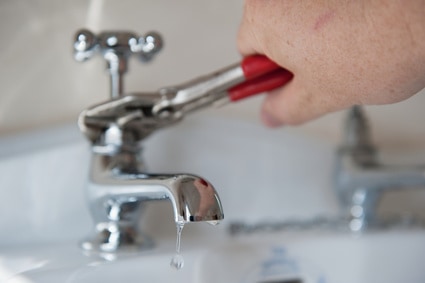
It’s easy for preventive commercial plumbing maintenance to fall by the wayside. For many owners of commercial buildings it feels like there’s always something more pressing to attend to. But as we know, ignoring routine maintenance tasks only works for so long until all of a sudden the issue you’re faced with is no longer able to be prevented. A plumbing system failure can be one of the most disruptive and unpleasant issues for building tenants, so routine maintenance is an important part of keeping your facility running smoothly.
4 Easy Steps for Commercial Plumbing Maintenance
Here are four steps that facility managers can take on a regular basis to avoid inconvenient and costly plumbing issues:
Prime floor drain traps: Drain traps need to stay full in order to do their job of blocking sewer gases. In most cases the cause of a sewer gas smell can simply be that all the water has evaporated from the floor drain. The simple solution is to add two cups of water, topped off with a half cup of vegetable oil. The oil stays on top of the water in the drain and acts as a seal to prevent evaporation. This solution works until the point that the oil has been diluted too much by new water flowing into the drain, so repeat as necessary when traps are dry.
Make sure toilet and urinal valves seal tightly: When valves get too worn to fully seal, water leaks can quickly add up. One medium-sized leak can waste 250 gallons of water per day – so there can be serious cost impacts from what may seem like insignificant leaks. You may be able to spot some leaks with a visual inspection. To catch even small ones, wipe the bowl dry with toilet paper and watch closely to see if a small stream starts flowing again. If you see a drip, it can likely be fixed with an inexpensive new valve.
Prevent avoidable clogs: You may have seen recently that many municipalities are dealing with a recent surge in problems caused by “flushable” wipes. The problems aren’t just at the city level – these wipes can cause clogs in your building as well. Take measures to educate building occupants and cleaning staff that even if a wipe is labeled flushable, it’s best to throw it in the trash after use. The same goes for feminine hygiene products. Urinal deodorizer cakes are another common cause of plumbing clogs. (In fact, some of us call them a plumber’s best friend.) If your facility uses these, consider switching to a liquid deodorizer. Even better, you can retrofit urinals with a motion-detector flush system, which negates the need for a deodorizing product.
Monitor roof drains: These systems get a lot of wear and tear between springtime snow melt and summer rains, and it’s not unusual for piping to pull apart from the drain itself, leading to significant water damage in an occupied space. We find that certain municipalities don’t enforce codes on roof drains as strictly as others, so even a brand new roof drain system might not be as robust as you’d think.
Once you’re committed to monitoring these often-overlooked plumbing issues, figure out the best way to incorporate it into your seasonal routine. Performing checks to coincide with daylight saving time clock changes is a good way to manage semi-annual tasks, or seasonal equinox dates are good reminders for quarterly checks.
If you need help assessing your building’s individual plumbing systems and determining the maintenance schedule that’s right for you, contact MAC Services for a customized plan.